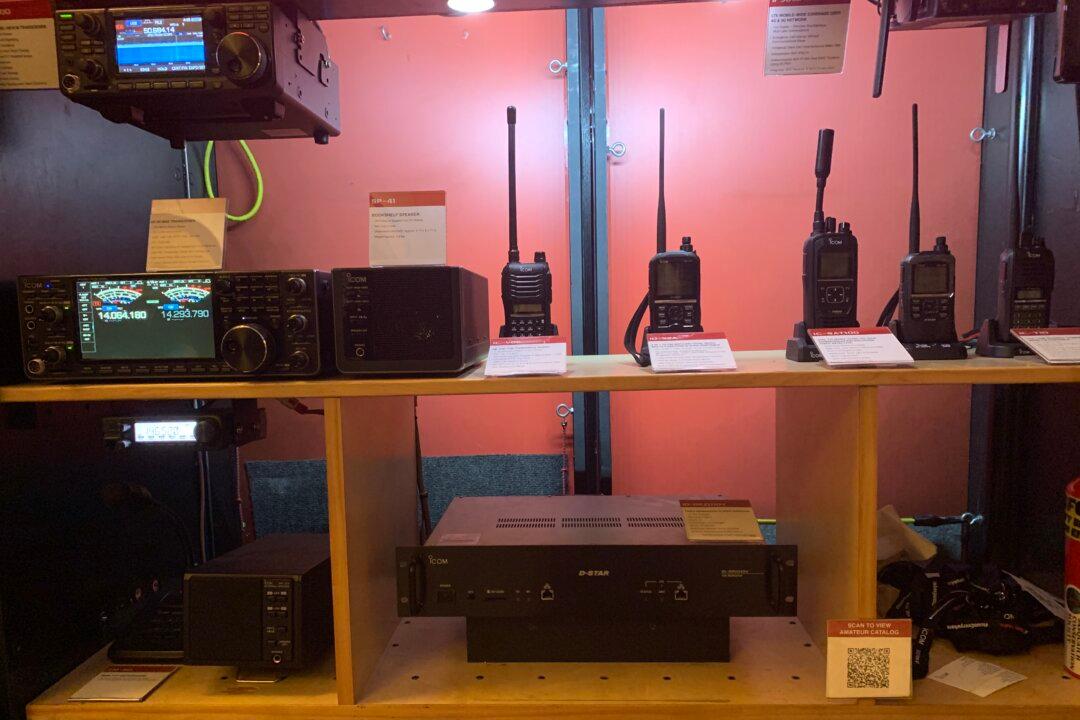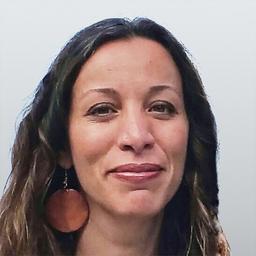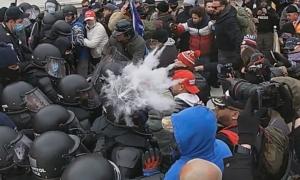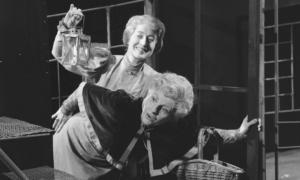Over 1,100 amateur radio operators (hams) descended on the Marriott Hotel in San Ramon, California, to attend the annual amateur radio convention called Pacificon on Oct. 20–22.
The three-day event included all things amateur radio (also known as ham radio), including forum presentations, ham radio license classes, license testing, ham radio nonprofit organization booths, kit building, a fox hunt, and more.
The forums spanned many different topics, including Ham Radio 101 for beginners, building an off-grid remote ham radio site, and much more.
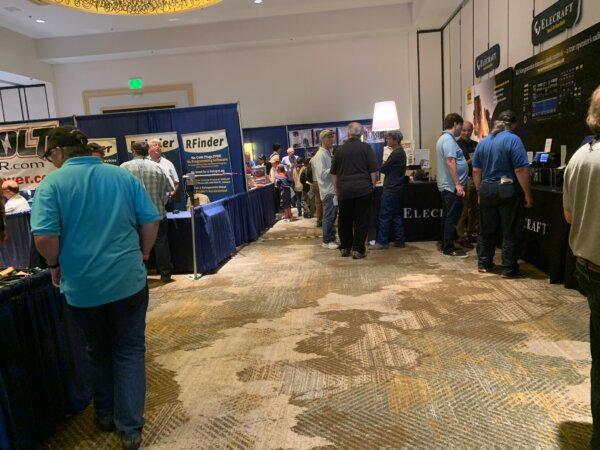
The Annual Amateur Radio Conference “Pacificon” in San Ramon, Calif., on Oct. 21, 2023. Helen Billings/The Epoch Times
On the second day of the event, Pacificon awarded a radio to the youngest ham for passing the technician exam.
Radios were also awarded to twin 11-year-old girls from Napa who passed their technician exams. They studied with and were brought to the event by their proud father, Nik.
According to the website “Ham Radio Deluxe” amateur radio is both a service and a hobby. It connects individuals from every part of the world via wireless communication. Licensed operators use radios that range from handheld models to dashboard mounts and remote shacks to communicate with other “hams” around the world.
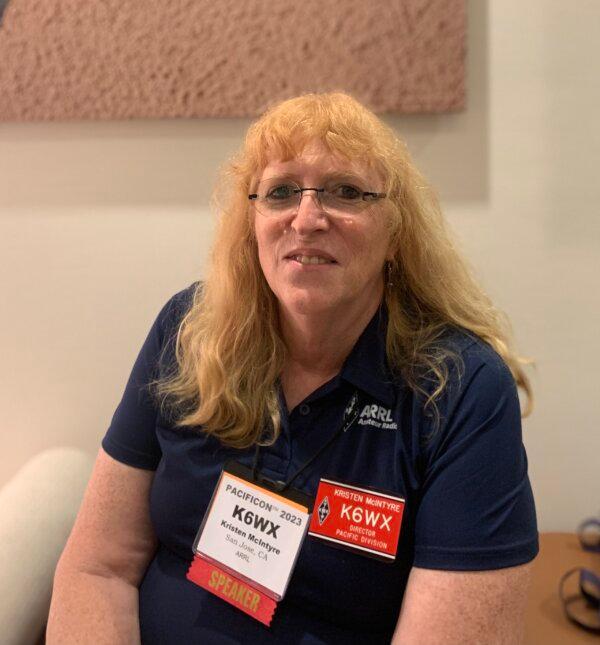
Kristen McIntyre, call sign K6WX, the Pacific Division Director of the American Radio Relay League (ARRL), at the Annual Amateur Radio Conference “Pacificon” in San Ramon, Calif., on Oct. 21, 2023. Helen Billings/The Epoch Times
Kristen McIntyre, the Pacific Division Director of the American Radio Relay League (ARRL), told The Epoch Times that call signs are assigned by the Federal Communications Commission (FCC), which created the ham radio licensing service. She said you can get a randomly assigned call sign or you can get a vanity call sign, which is like getting a custom license plate. Her call sign is K6WX.
She said ham radio has three levels to the licensing. There’s technician, general, and extra class licenses, and each advancing license class opens up additional operating privileges.
She said the FCC rules state that you are required to say your call sign every 10 minutes after you start transmitting and then at the end of your communication.
She said, “Our call signs are like our names; we’re very proud of them.”
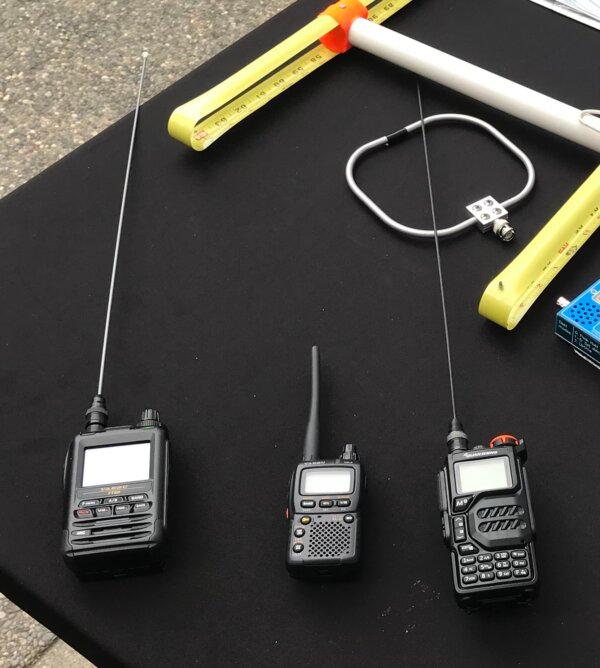
Handheld ham radios at the Annual Amateur Radio Conference “Pacificon” in San Ramon, Calif., on Oct. 21, 2023. Keegan Billings/The Epoch Times
She said the need for licensing came about because there was chaos on the air and everybody was conflicting with each other, mostly due to the limitations of the equipment at the time, so the FCC created the licensing and the Communications Act of 1923. She said, “The government, of course, also wanted to know who’s on the air.”
She said you can’t start a radio station over ham radio, and commercial enterprises are not allowed.
Although the police and fire departments do not use ham radio, they do team up with emergency communications groups and organizations that are mostly composed of amateur radio operators for emergencies, since they have the expertise with ham radio equipment, she said.
She said that amateur radio was the only communication after the wildfire in Lahaina, Hawaii, because the fire burned down the infrastructure for other means of communicating. She said that was also true for the Fort Myers area in Florida when it was hit by Hurricane Ian last year.
She said it’s a good idea for people to get licensed and keep a ham radio in their emergency supply kit at home.
Ms. McIntyre shared that one time she was out on a motorcycle ride and stopped for a coffee, and when she came out, the battery was dead. She called AAA and they told her they don’t do motorcycles.
So she pulled out her radio and asked if anybody out there could come over and give her a jump on the motorcycle.
“Sure enough, there was one of my friends, Andreas, and he said, yeah, sure, where are you? And he came over, and he helped me get just enough energy into that battery so I could get it home,” she said. “It’s just that helping spirit … and you see that kind of thing all the time.”
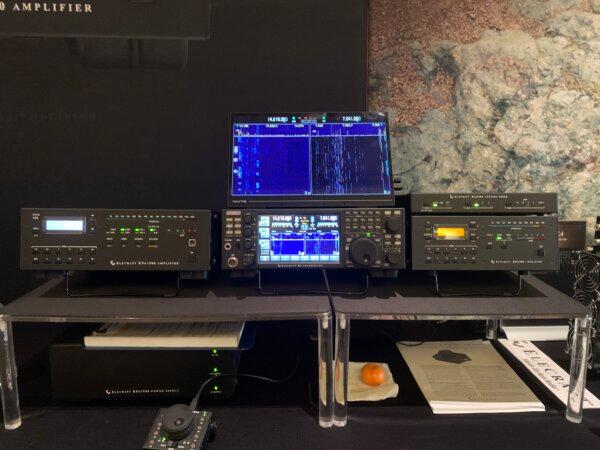
Elecraft amateur radio equipment on display at the Annual Amateur Radio Conference “Pacificon” in San Ramon, Calif., on Oct. 21, 2023. Helen Billings/The Epoch Times
Bob Wolbert, call sign K6XX, is a ham from Santa Cruz County and an employee of Elecraft, an amateur radio manufacturer. He told The Epoch Times, “We can communicate from our house, our car, to other people, 5,000, 10,000 miles away, without any infrastructure.”
He said that ham radio doesn’t need to use the internet or electricity. They can communicate right now in real time, no delay, with just battery-powered radios.
He said, “From a preparedness viewpoint, it’s valuable.”
Mr. Wolbert said he got into ham radio the summer between sixth and seventh grade and has been a ham for almost five decades.
He said he was reading books in the library with references and stories about ham radio that sparked his interest.
“It just sounded like a really interesting way of communicating with people,” he said. “I guess I wanted to have my voice heard, whether or not I had a message.”
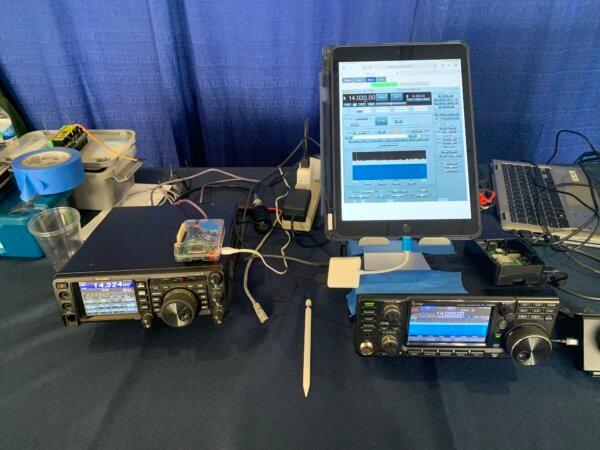
Amateur radio equipment on display at the Annual Amateur Radio Conference “Pacificon” in San Ramon, Calif., on Oct. 21, 2023. Helen Billings/The Epoch Times
Later on in life, he got involved in the competitive aspect of amateur radio. He said it keeps his mind sharp.
The main point of the competition is to use the radio to talk to as many people as possible during a fixed time limit, he said.
He competed in a California ham radio contest in early October. He was able to talk to about 2,650 people in 24 hours, breaking his personal record, he said.
He also mentioned the World Radiosport Team Championship, which is held every four years and is basically like an Olympic event.
“Like in the Olympics, you have to have them gather everyone together and have one competition, at one time, in one place, to find out who’s the best,” he said.
They compete in one place to level the playing field, because depending on where you are located geographically, it could be easier or harder to communicate with different parts of the world.
He said people qualify by region, basically by country, and during the competition they all use the same antenna and the same basic facilities. He said there’s an onsite referee sitting next to them and making sure they follow the rules of the competition.
In July, Mr. Wolbert and his teammate competed against 59 other teams in the World Radiosport Team Championship in Bologna, Italy, the home of Guglielmo Marconi, who he said is debated as the inventor of the radio along with Heinrich Hertz and Aleksandr Popov.
“We ended up in the middle of the pack,” he said.
He said the winning team was from Ukraine.
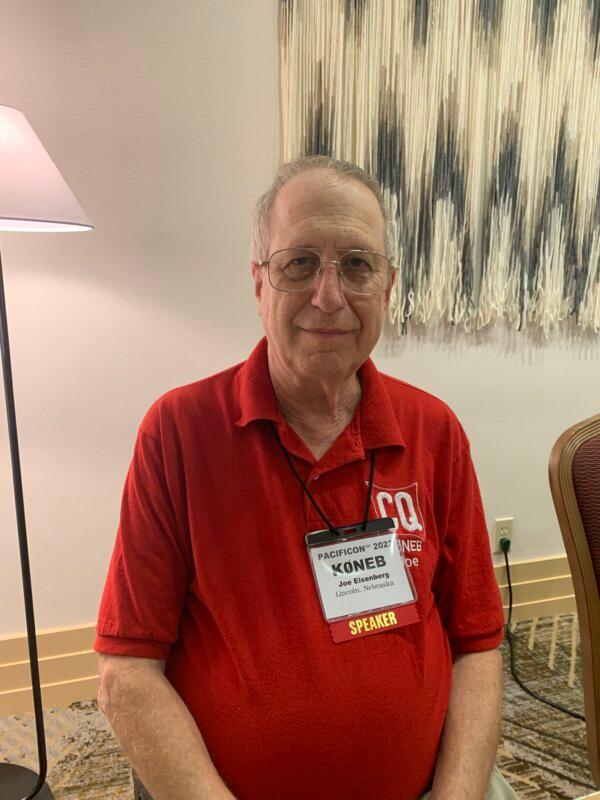
Joe Eisenberg, call sign K0NEB, a ham radio enthusiast from Nebraska, at the Annual Amateur Radio Conference “Pacificon” in San Ramon, Calif., on Oct. 21, 2023. Helen Billings/The Epoch Times
Joe Eisenberg, a ham radio enthusiast from Nebraska and a writer for the magazine CQ Amateur Radio, said ham radio got the name “ham” because amateur actors in the vaudeville days were called “ham actors,” so ham radio took on the name too.
He said commercial users and amateurs used to share the same radio frequencies, so the government pushed amateur radio up to the higher frequencies, because the lower ones, which propagated day and night, were more valuable.
“But they had no idea that radio waves at much higher frequencies would go up and skip off the ionosphere and go halfway around the world, and we discovered that,” he said.
Pushing amateurs away from the mainstream enabled them to discover important technologies that are still in use today, he said.
He said new technologies weren’t coming out of the laboratories; they were coming out of people’s basements, and the amateurs were the ones designing things and creating new things and new ways to communicate.
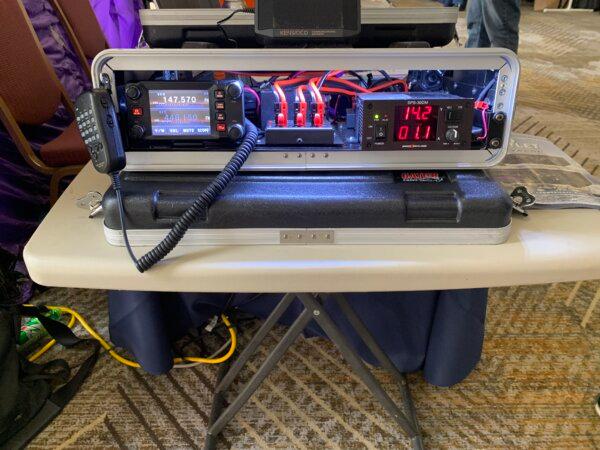
Amateur radio equipment on display at the Annual Amateur Radio Conference “Pacificon” in San Ramon, Calif., on Oct. 21, 2023. Helen Billings/The Epoch Times
He said the FCC and international regulations do not allow hams to encrypt their communications, but they use digital modes of communication in which their voices are made digital—just like with a cell phone, but those codes are public.
So if they had a special receiver, they could still listen to it, but a simple receiver would not be able to receive the digital communications.
He said their communications are public, and they don’t do anything in secret.
Mr. Eisenberg shared a story that happened when he was a child. He said one of the things hams like to do is get on the radio and call “CQ,” which is a random invite to anybody who can hear to chat. He said it’s probably one of the best kinds of random phone calls you could make.
He said he called CQ and a guy named Barry answered with his callsign and everything. Mr. Eisenberg told Barry he was a high school student in Omaha, Nebraska, and Barry said he was a U.S. senator from Arizona. Mr. Eisenberg said it was Barry Goldwater.
Mr. Eisenberg said his mother was sitting behind him at the time, and she said to tell Mr. Goldwater that they were going to Phoenix next week to stay with Mr. Eisenberg’s grandparents. So Mr. Eisenberg did.
Mr. Goldwater then asked if he would like to visit his station at his house in Scottsdale, and the boy replied that he would love to. Mr. Goldwater said Thursday would be fine.
Mr. Goldwater said to have the grandparents call his office, and they would make arrangements for the visit.
Mr. Eisenberg said that his mom then called her mother on the phone. Her mother remarked that she had served on the Maricopa County Republican committee for 15 years, and it was her grandson who had gotten her invited to see Barry Goldwater.
He said it was fun to meet Barry Goldwater and he was a very nice guy.
Mr. Eisenberg said his call sign is K0NEB, which used to belong to the Nebraska State Fair. He said since it hadn’t been in use for 30 years and was never reassigned, he asked for it. He liked that the last three letters let people know that he is in Nebraska.
He said people have been connecting over ham radio for a long time, starting with Morse code and later using speech.
“We call ham radio ‘the first social media,’” he said.
They have on-air meetings in which one person will act as an emcee; they call him the net control. He said it’s kind of like a roundtable conversation.
He said they pass news, information, and other topics that way. If something bad has happened, they can let each other know because they aren’t going to get it off their phones, he said.
There is only one country in the world that does not allow amateur radio, and that is North Korea, he said.
He said the three topics that you’re supposed to avoid on the radio are politics, religion, and sex. He said they try not to let politics get in the way; it is about true international goodwill and friendship.
He said it’s considered bad to get on the radio and badmouth domestic or international politics. He said if that became the norm, other governments might stop allowing the hobby of ham radio because it could be a threat to their existence.
He was recently talking with some friends in Israel to touch base and see if they were okay.
He said, “We’re not going to do tactical, military-type communications. We’re going to be connecting civilians to each other.”
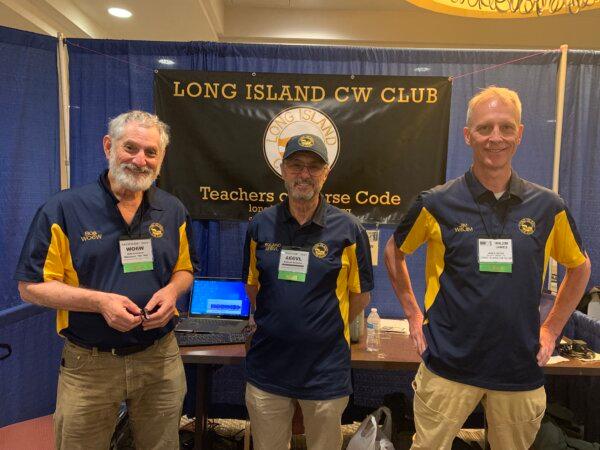
The Long Island CW Club Teachers of Morse Code booth at the Annual Amateur Radio Conference “Pacificon” in San Ramon, Calif., on Oct. 21, 2023. Helen Billings/The Epoch Times
Jim Crites, call sign W6JIM, of the Long Island CW (Continuous Wave) Club—Teachers of Morse Code from Walnut Creek, California, told The Epoch Times that their specialty is taking people who don’t know anything about Morse code and teaching them from the ground up.
He said after they cover the basics to get you on the air and use CW (Morse code) in a conversation form, they move on to classes like how to hear, how to copy, how to send, and how to increase your speed.
He said the reason that they are doing this is because they have a lot of fun and want people to come and participate.
The club had a little over a hundred members in 2018 and has grown to over 4,300 members in 2023.
Bob Leichner, call sign WO6W, of the Long Island CW Club from Menlo Park, California, said they have 95 classes and they are offered entirely on Zoom.
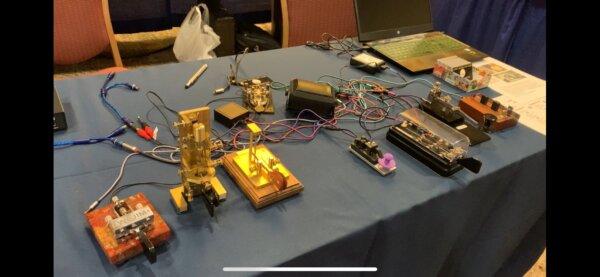
Morse code equipment at the Annual Amateur Radio Conference “Pacificon” in San Ramon, Calif., on Oct. 21, 2023. Helen Billings/The Epoch Times
He said one of their members is with NASA, and he gave a talk about radio, astronomy, and background radiation. He taught how to use a receiver that can measure the background radiation at home.
Mr. Leichner said he got into CW because it was really frustrating operating in Menlo Park with low power and without a great antenna. He said it’s not a very efficient mode of communication.
He said when a voice is transmitted it is spread out over a broad range of frequencies, and it can be a very quiet signal. If you take that same energy and concentrate it on one frequency, a CW signal, it is much more efficient and can get beyond the limitations of a poor antenna and low power.
Mr. Leichner said there is a member in the club who’s dealing with dementia, and CW is brain pushups. It keeps his mind engaged and challenges him in ways that are helping him.
“That’s priceless,” Mr. Leichner said.
There are at least a handful of members in the club for that reason—they want to exercise their brains, said Mr. Leichner.
He said they offer a CW haptics device on their website that helps people who are deaf or hard of hearing to decipher incoming Morse code. He said as the signal passes through the box, it lights up and vibrates the Morse code signal as well as playing it out of a speaker.
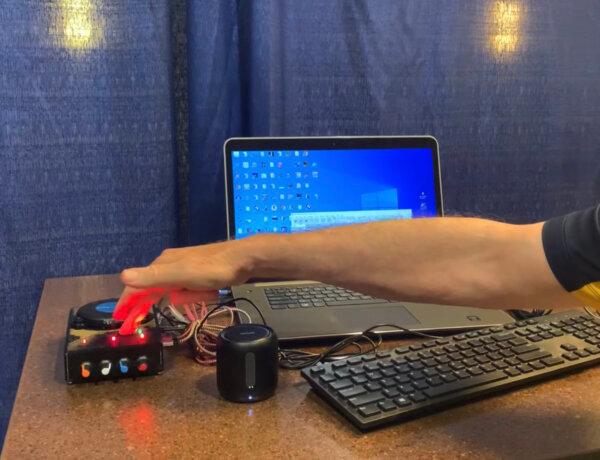
A light-up and vibrating device for delivering CW (Morse code) to the deaf and hard of hearing, at the Annual Amateur Radio Conference “Pacificon” in San Ramon, Calif., on Oct. 21, 2023. Helen Billings/The Epoch Times
Roland Williams, call sign AE6VL, of the Long Island CW Club from Martinez, California, told The Epoch Times that the most important thing about CW is that it’s a challenge.
He said if you want mental plasticity and you want to offset all the agonies of getting older, then CW is a good mental exercise.
“You learn to copy stuff in your head instead of writing it down. It’s like learning another language,” he said.
He said it’s demanding and super challenging but a lot of fun.
Since he is right-handed, Mr. Williams said his most recent challenge was learning to send Morse code with his left hand so his right hand would be free to write down the incoming signal.
He said, “Now I don’t need to pick a pen up or put a pen down to send.”
Mr. Leichner shared a fond memory from when he was about 11 years old. He said there was a tower at a house at the end of his street, and he became curious about it, so he went and knocked on the door to meet the people.
He said they were wonderful folks and every weekend they got on their radio in California and talked to their son who lived in Texas.
“I remember going down there weekend after weekend ... to sit with this really lovely older couple and watch the glowing dials as they talked to their son, and that was magic for me,” he said. “You can take a radio that will literally fit in a pocket, and some wire and a battery, up to the top of a mountain, and you can be talking to the world in CW. You can’t do that anywhere near as easily with voice.”
